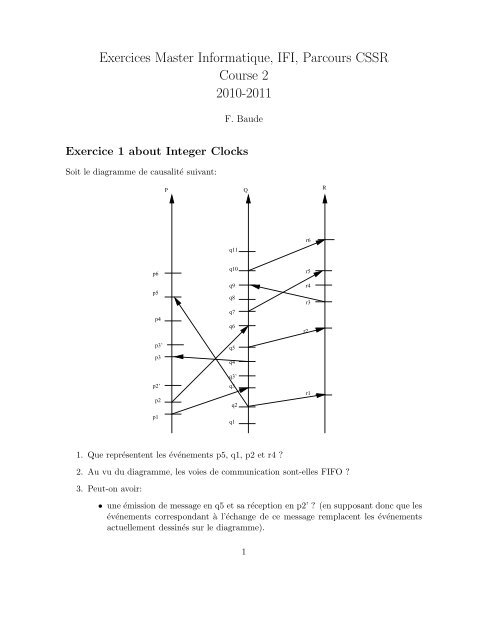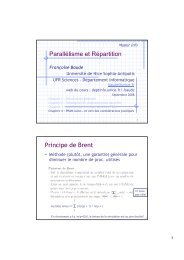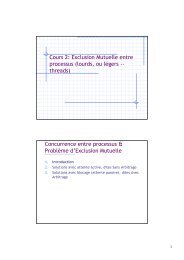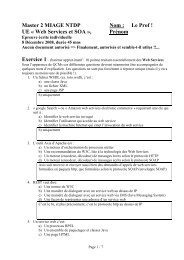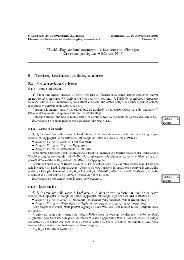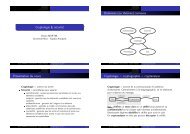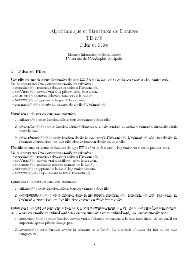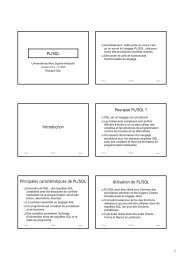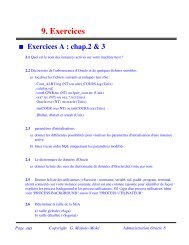Exercices Master Informatique, IFI, Parcours CSSR Course 2 2010 ...
Exercices Master Informatique, IFI, Parcours CSSR Course 2 2010 ...
Exercices Master Informatique, IFI, Parcours CSSR Course 2 2010 ...
Create successful ePaper yourself
Turn your PDF publications into a flip-book with our unique Google optimized e-Paper software.
<strong>Exercices</strong> <strong>Master</strong> <strong>Informatique</strong>, <strong>IFI</strong>, <strong>Parcours</strong> <strong>CSSR</strong><br />
<strong>Course</strong> 2<br />
<strong>2010</strong>-2011<br />
F. Baude<br />
Exercice 1 about Integer Clocks<br />
Soit le diagramme de causalité suivant:<br />
P<br />
Q<br />
R<br />
q11<br />
r6<br />
p6<br />
p5<br />
p4<br />
p3’<br />
p3<br />
p2’<br />
p2<br />
p1<br />
q10<br />
q9<br />
q8<br />
q7<br />
q6<br />
q5<br />
q4<br />
q3’<br />
q3<br />
q2<br />
q1<br />
r5<br />
r4<br />
r3<br />
r2<br />
r1<br />
1. Que représentent les événements p5, q1, p2 et r4 ?<br />
2. Au vu du diagramme, les voies de communication sont-elles FIFO ?<br />
3. Peut-on avoir:<br />
• une émission de message en q5 et sa réception en p2’ ? (en supposant donc que les<br />
événements correspondant à l’échange de ce message remplacent les événements<br />
actuellement dessinés sur le diagramme).<br />
1
• une émission de message en p3’ et sa réception en q3’ (même remarque que pour<br />
le point précédent) ?<br />
4. En considérant les horloges de Lamport initialisées à 0, quelles sont les valeurs des<br />
horloges en P après p6, en Q après q11 et en R après r6 ?<br />
5. Quelle est la durée maximum de l’algorithme décrit par ce diagramme (on néglige la<br />
durée des événements locaux et on considère que la durée d’une transmission est bornée<br />
par τ max). De même, donner la durée minimum de l’algorithme (ou dit autrement,<br />
donner la profondeur du diagramme d’événements).<br />
6. Quels sont les événements incomparables (au sens de la relation de causalité) de q6 ?<br />
7. Montrer que si 2 événements a et b sont tels que heure(a) < heure(b), on n’a pas<br />
nécessairement que a précède b au sens de la relation de causalité.<br />
Exercice 2 about Vector Clocks<br />
On considère le diagramme temporel (dessiné en figure 1) associé à un algorithme distribué<br />
faisant intervenir 3 processus P1,P2,P3 et les événements a 1 ,b 1 ,c 1 ,d 1 sur P1, a 2 ,b 2 ,c 2 ,d 2<br />
sur P2, a 3 ,b 3 ,c 3 sur P3.<br />
C<br />
C’ C’’<br />
P3<br />
a3<br />
b3<br />
c3<br />
P2<br />
a2<br />
b2<br />
c2<br />
d2<br />
P1<br />
a1<br />
b1<br />
c1<br />
d1<br />
Figure 1: Diagramme temporel<br />
1<br />
Est-ce que la façon dont est présenté ce diagramme temporel utilise l’idée du modèle atomique<br />
(voir article en anglais de Lamport) ?<br />
2
2<br />
Calculer les estampilles de Lamport (entiers) pour chacun de ces événements.<br />
3<br />
Calculer les “horloges vectorielles” (vecteurs à 3 composantes) pour chacun de ces événements.<br />
4<br />
Commenter les valeurs des vecteurs estampillant les événements c1 et c3.<br />
5<br />
Dire comment les événements b3 et c2 estampillés par les horloges de Lamport se comparent<br />
(sont-ils comparables selon la relation de causalité notée →) ?<br />
Puis, en considérant leur estampille vectorielle, dire comment ces événements b3 et c2 se<br />
comparent.<br />
Recommencer exactement la même question en considérant à présent les événements b3<br />
et d2.<br />
6<br />
Décrire en termes d’événements les coupes C, C ′ , C ′′ . Sont-elles cohérentes ?<br />
7<br />
Soit r i le nombre de messages reçus par P i et s i le nombre de messages émis par P i pour une<br />
coupe C. Calculer ∑ i r i = R et ∑ i s i = S pour les coupes C, C ′ , C ′′ .<br />
8<br />
Est-ce que les valeurs obtenues pour la coupe C ′′ permettent de conclure que l’algorithme est<br />
terminé ?<br />
Exercice 3 (from Chapter 6 of Ghosh)<br />
The limitation of timestamps is their unbounded size, since finite resources are inadequate to<br />
store or process them. The goal of this exercise is to explore if bounded-size timestamps can<br />
be used in specifc solutions. Expore this possiblity in the following scenario: Two processes<br />
(0,1) compete with each other to acquire a shared resource that can be used by one process<br />
at a time. The life of the processes are as follows:<br />
Process i (i = 0 or 1)<br />
do<br />
true -><br />
Request for a resource;<br />
Acquire and use the resource;<br />
3
od<br />
Release the resource<br />
To request the resource, a process sends a timestamped request to the other process, which<br />
grants the request only if (i) it is not interested in the resource at that moment, or, (ii) its<br />
own timestamp for resource request is larger than the timestamp of the incoming request. In<br />
all other situations, the grant is deferred. After receiving the grant, a process acquires the<br />
resource. Once a process acquires a resource, it guarantees to release the resource within a<br />
finite amount of time. Thereafter, in a finite time, the resource is released.<br />
Can you solve the problem using timestamps of bounded size ? Explain your answer.<br />
(Hint: First find out what is the maximum difference between the timestamps of the two<br />
processes if the timestamps are unbounded. The timestamp of bounded size must resolve the<br />
order of requests without any ambiguity.)<br />
Exercice 4 (adapted from one from Chapter 6 of Ghosh)<br />
In a network of N processes (N>2), all channels are FIFO (and bi-directional), and of infinite<br />
capacity. Every process is required to accept data from the other processes in strictly<br />
increasing order of timestamps. You can assume (i) processes send data infinitely often,<br />
and (ii) no messages is lost in transit.<br />
First, build a 3 processes example, that illustrates this requirement on the following scenario:<br />
Process P1 sends 2 messages, one to P2, one to P3. On reception, P3 sends a new<br />
message to P2. All messages are timestamped using Lamport’s clocks.<br />
Then, propose an implementation to make it possible that processes respect the requirement.<br />
(Hint: Consider using null messages through a channel to signal the absence of a<br />
message from a sender).<br />
Exercice 5 (from Chapter 8, Ghosh)<br />
Construct an example to show that Chandy-Lamport distributed snapshot algorithm does<br />
not work when the channels are not FIFO.<br />
Exercice 6 (from Chapter 11, Coulouris and al. book)<br />
Two processes P and Q are connected in a ring using two-channels, and they constantly rotate<br />
a message m. At any one time, there is only one copy of m in the system. Each process’s<br />
state consists of the number of times it has received m, and P sends m first. At a certain<br />
point, P has the message and its state is 101. Immediately after sending m, P initiates the<br />
snapshot algorithm. Explain the operation of the algorithm in this case giving the global<br />
state reported by it.<br />
4


